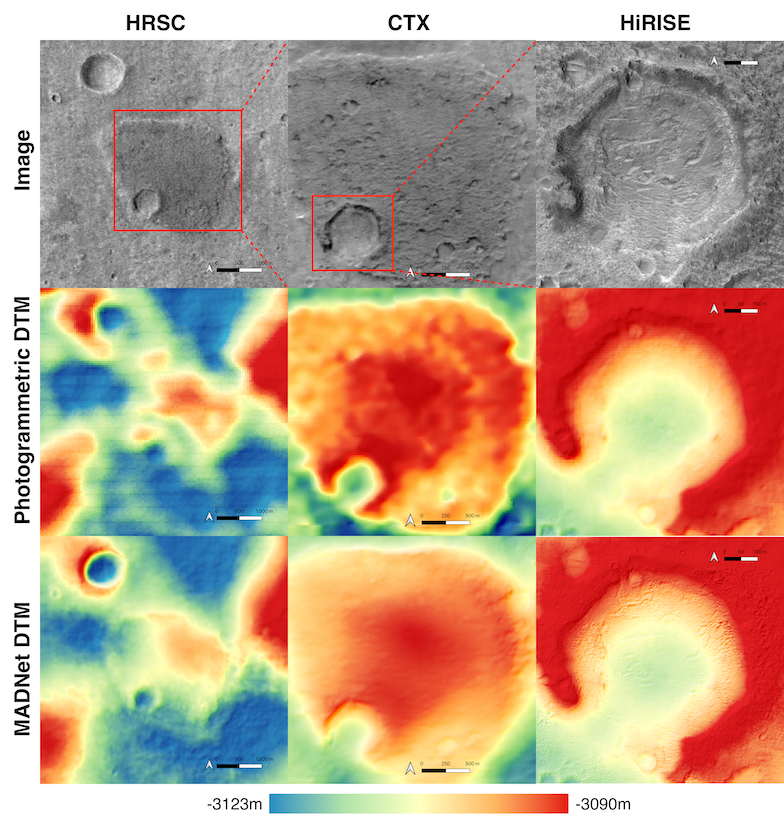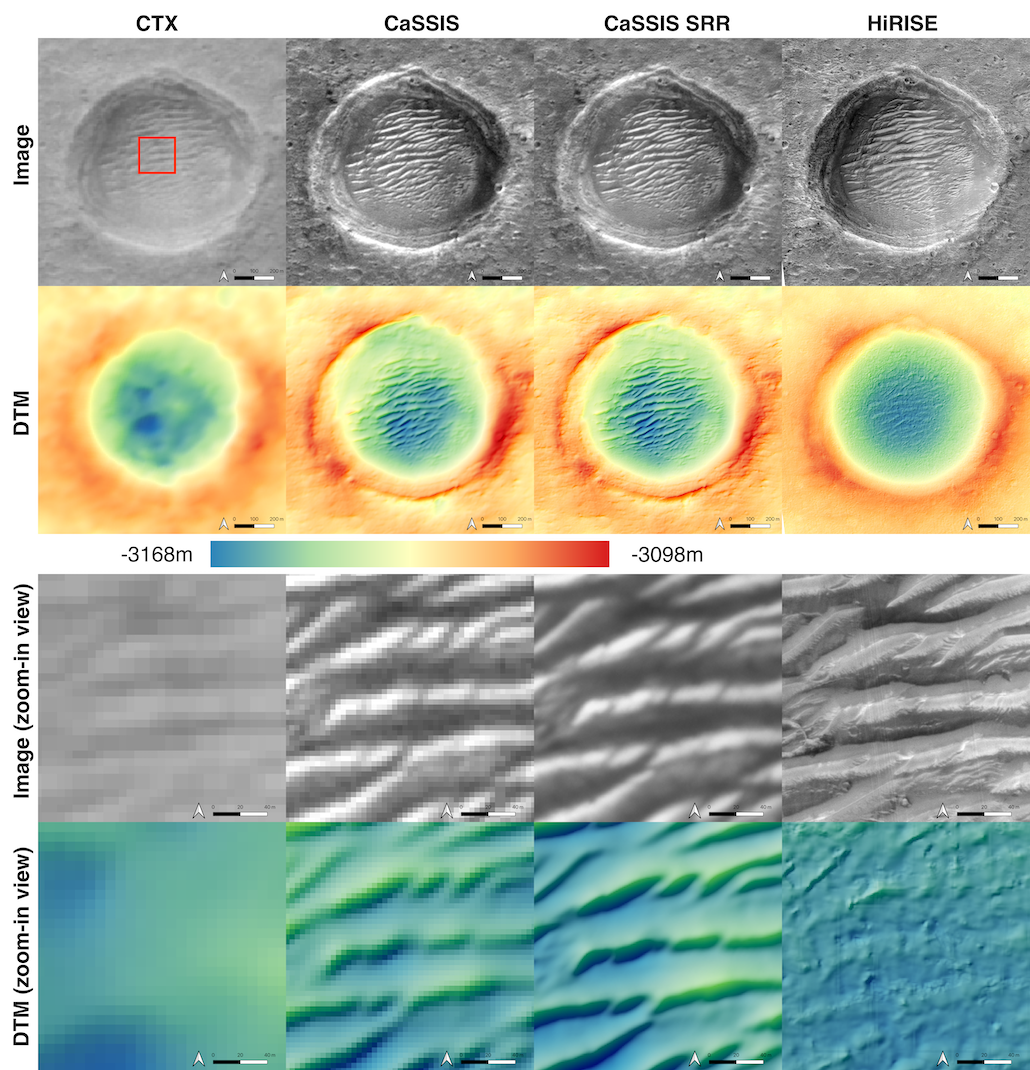Very-high-resolution rapid 3D mapping of Oxia Planum using cascaded MOLA-HRSC-CTX-HiRISE
- 1Imaging Group, Mullard Space Science Laboratory, University College London, Dept. Space and Climate Physics, UK (yu.tao@ucl.ac.uk; j.muller@ucl.ac.uk)
- 2CNRS, Laboratoire de Planétologie et Géodynamique, 2 rue de la Houssinière, Nantes, France
Very-high-resolution rapid 3D mapping of Oxia Planum using cascaded MOLA-HRSC-CTX-HiRISE
Y. Tao (1), J-P. Muller (1), S. J. Conway (2)
(1) Imaging group, Mullard Space Science Laboratory, University College London, Holmbury St Mary, RH5 6NT, UK (yu.tao@ucl.ac.uk; j.muller@ucl.ac.uk), (2) CNRS, Laboratoire de Planétologie et Géodynamique, 2 rue de la Houssinière, Nantes, France (susan.conway@univ-nantes.fr)
Abstract
Stereo photogrammetry and/or photoclinometry have long been applied to the production of 3D imaging datasets for planetary surfaces. However, insufficient image resolution or reductions in the resultant 3D resolution, the lack of adequate stereo coverage and where available, lengthy processing time, various matching artefacts or noise effects, and unsatisfactory quality and complexity of processing, have long been significant barriers for large-area planetary 3D mapping. In this work, we demonstrate how deep learning based solutions can address the above issues using a single image and a coarse 3D reference as inputs.
1. Introduction
We demonstrate a very high-resolution rapid 3D mapping techniques and results over Oxia Planum, the forthcoming Rosalind Franklin ExoMars 2022 rover landing site. This uses a combination of deep learning based single-image super-resolution restoration (SRR), deep learning based single-image digital terrain model (DTM) estimation, and cascaded 3D co-alignment methods.
2. MARSGAN SRR
Improving the spatial resolution of Mars orbital images allows us to extract greater amounts of information about the nature of the surface, how it formed and has changed over time. One of the options to achieve a greater spatial resolution is through the use of SRR techniques. Recently, we have developed a single-image deep learning based SRR system, using Multi-scale Adaptive-weighted Residual Super-resolution Generative Adversarial Network (MARSGAN) [1], to be able to produce full-strip TGO CaSSIS SRR images within a few minutes. The MARSGAN SRR system can be similarly applied to MRO CTX and HiRISE images as demonstrated in [1].
3. MADNet DTM
The lack of adequate stereo coverage and where such coverage is available, the lengthy processing times, various artefacts and insufficient resolution, have long been big barriers for large-area planetary 3D mapping. Recently, we have developed a single-image deep learning based DTM extraction system, using Multi-scale generative Adversarial U-Net with Dense convolutional block and up-projection (MADNet) [2], to be able to produce high-quality, high-resolution, and artefact-free full-orbital strip CaSSIS DTM within a few seconds. The MADNet DTM system can be similarly applied to MEX HRSC, CTX, and HiRISE images as shown in [2]. Figure 1 shows examples of the MADNet DTM results compared to photogrammetric DTMs for HRSC (PSA MC11 product), CTX (SocetSet® product produced at NHM & OU), and HiRISE (SocetSet® PDS product).

Figure 1. Examples of MADNet DTM results compared to photogrammetric DTMs for HRSC (PSA HRSC MC11 product), CTX (SocetSet® product produced at NHM & OU), and HiRISE (SocetSet® PDS product). Figure taken from [2].
4. Combining MARSGAN and MADNet
The MARSGAN SRR and MADNet DTM system can be efficiently and effectively coupled to produce high-resolution DTMs at subpixel-scale of the input images similar to [3], where we demonstrated MARSGAN SRR with photoclinometry to produce ultra-high-resolution DTMs. Figure 2 shows examples of using MARSGAN SRR coupled with photoclinometry for subsequent very-high-resolution DTM production.

Figure 2. Examples of using MARSGAN SRR for sub-pixel DTM production. Figure taken from [3].
5. 3D Co-alignment and Large-area 3D Mapping
Recently, we have demonstrated an effective image co-registration and B-Spline fitting based 3D co-alignment method to correct for 3D errors using a coarse reference DTM (e.g., MOLA) [4]. Through 3D co-alignment and a coarse-to-fine reconstruction strategy, large-area DTM mosaics can be produced via a sequence of processing steps including: MADNet HRSC DTM production, 3D co-alignment of HRSC DTM and MOLA, MADNet CTX DTM production, 3D co-alignment of CTX DTM and HRSC DTM, MADNet HiRISE DTM production, 3D co-alignment of HiRISE and CTX DTM, MARSGAN SRR of HiRISE, MADNet DTM production using HiRISE SRR image, and 3D co-alignment of HiRISE SRR DTM and HiRISE DTM. Results will be shown of these different examples.
6. Conclusions
In this work, we describe the deep learning based SRR and DTM systems. Potential issues or limitations discussed in [1] and [2] will be studied in detail. Differences between each cascaded DTM products will be validated. As the final product, we demonstrate over Oxia Planum, a high-quality, high-resolution, artefact free, fully co-aligned cascaded DTM mosaics from HiRISE/CTX/HRSC, using a combination of the MARSGAN SRR and MADNet DTM system.
Acknowledgements
The research leading to these results is receiving funding from the UKSA Aurora programme (2018-2021) under grant no. ST/S001891/1. The research leading to these results also received partial funding from the European Union’s Seventh Framework Programme (FP7/2007-2013) under iMars grant agreement n˚ 607379. SJC is grateful for the financial support of CNES in support of her HiRISE work.
References
[1] Tao Y, Conway SJ, Muller J-P, Putri ARD, Thomas N, Cremonese G. Single Image Super-Resolution Restoration of TGO CaSSIS Colour Images: Demonstration with Perseverance Rover Landing Site and Mars Science Targets. Remote Sensing. 2021; 13(9):1777.
[2] Tao Y, Xiong S, Conway SJ, Muller J-P, Guimpier A, Fawdon P, Thomas N, Cremonese G. Rapid Single Image-based DTM Estimation from ExoMars TGO CaSSIS Images using Generative Adversarial U-Nets. Remote Sensing, 2021 (under review).
[3] Tao Y, Douté S, Muller J-P, Conway SJ, Thomas N, Cremonese G. Ultra-high-resolution 1m/pixel CaSSIS DTM using Super-Resolution Restoration and Shape-from-Shading: Demonstration over Oxia Planum on Mars. Remote Sensing, 2021 (under review).
[4] Tao Y, Michael G, Muller J-P, Conway SJ, Putri ARD. Seamless 3D Image Mapping and Mosaicing of Valles Marineris on Mars Using Orbital HRSC Stereo and Panchromatic Images. Remote Sensing. 2021; 13(7):1385.
How to cite: Tao, Y., Muller, J.-P., and Conway, S.: Very-high-resolution rapid 3D mapping of Oxia Planum using cascaded MOLA-HRSC-CTX-HiRISE, European Planetary Science Congress 2021, online, 13–24 Sep 2021, EPSC2021-790, https://doi.org/10.5194/epsc2021-790, 2021.

